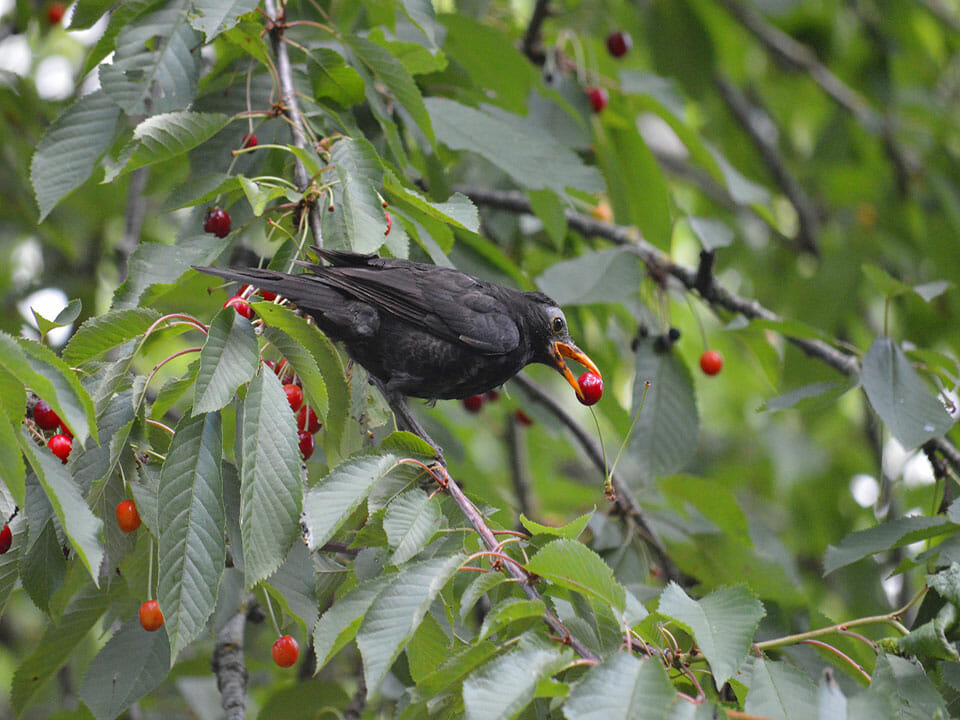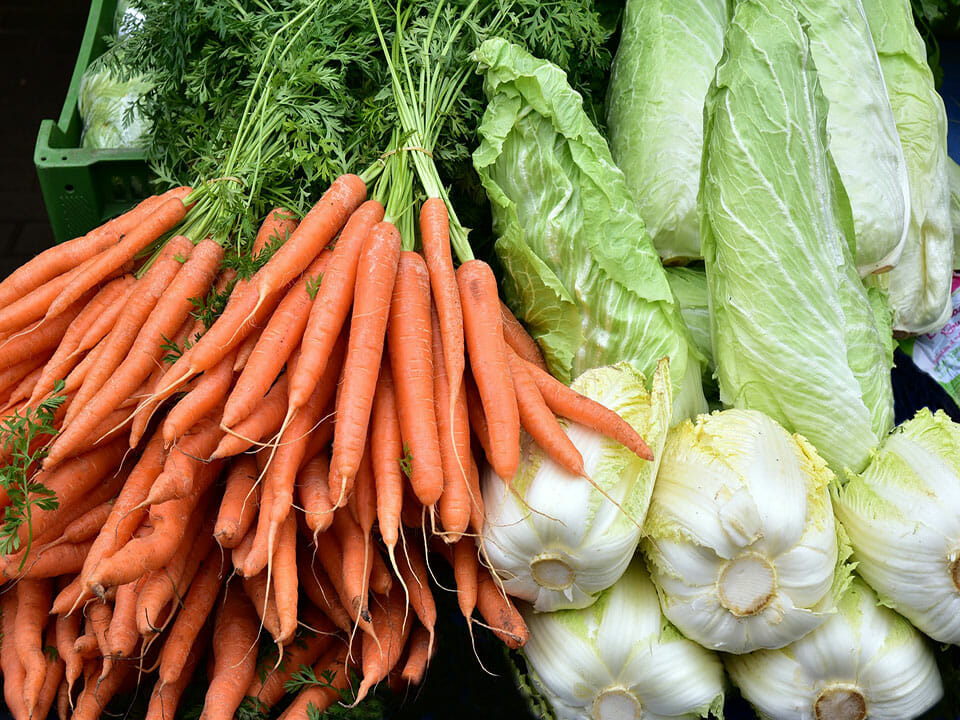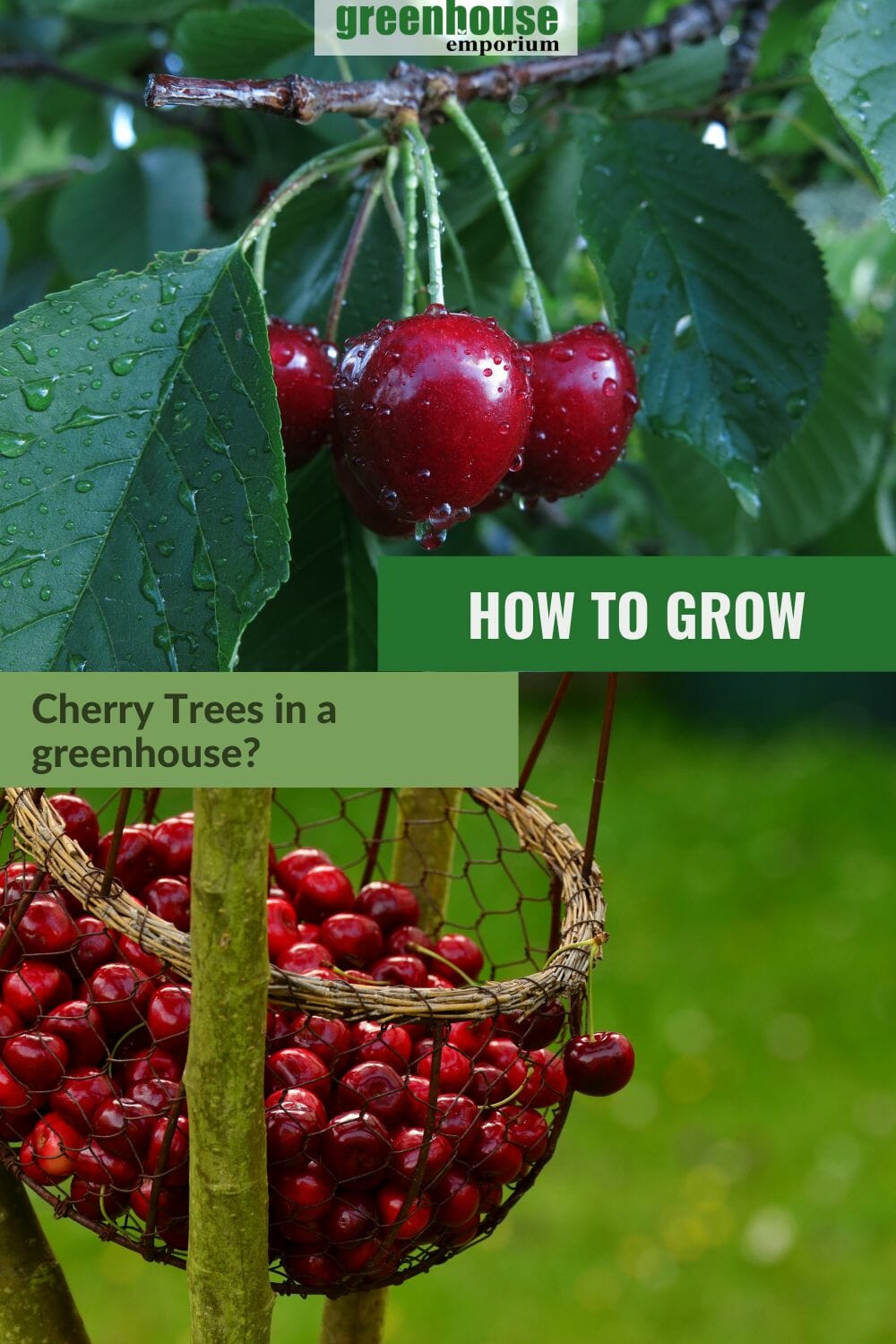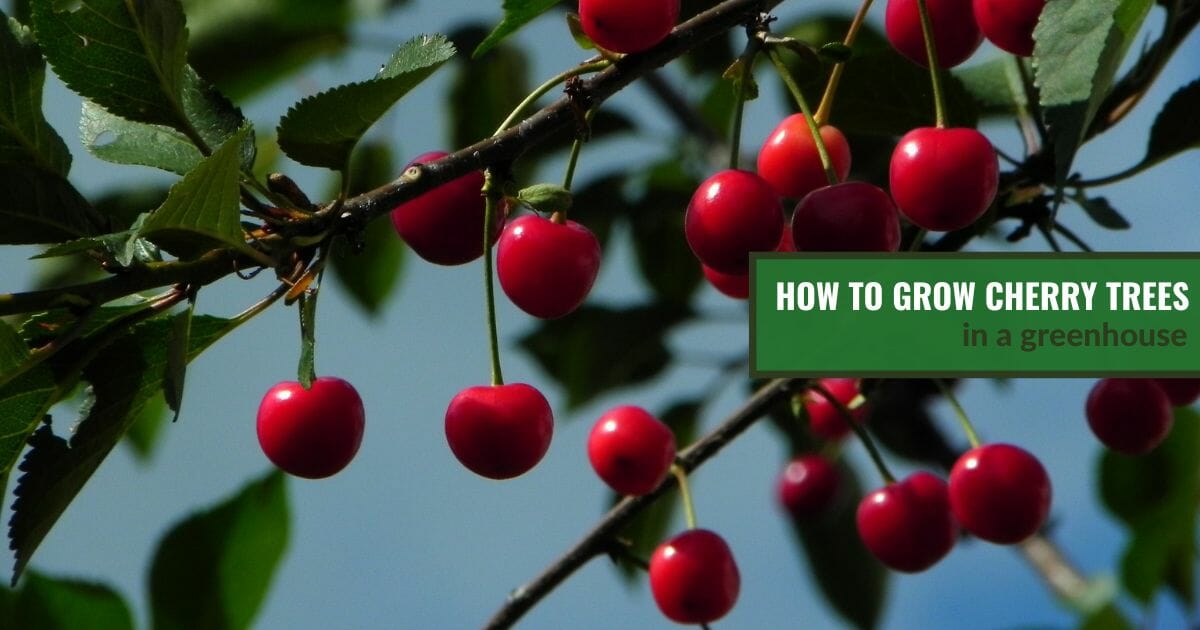


Would you like to grow your own cherries, but live in a climate that’s either too hot or too cold for them? Fortunately, a greenhouse can solve this issue. By growing cherry trees in a protected environment, you can not only prevent birds from eating your precious fruit, but you can provide the trees with the conditions they need to thrive.
You can successfully grow cherry trees in a greenhouse with a little effort. It starts with choosing dwarf varieties that remain fairly small in size. You can even keep these trees in pots to limit their growth and move them around according to the seasons or your needs.
Both sweet and sour cherries can be grown in a greenhouse with success. Whether you’re looking to eat fresh cherries or make a delicious pie filling, growing cherry trees is incredibly rewarding. Before you head out to the nursery, however, let’s go over a few things you need to know about growing cherry trees in a greenhouse.
Why grow cherry trees in a greenhouse?
Whether it’s snowing or scorching hot outside, a greenhouse can keep plants protected and thriving. Of course, there are limitations, but with a greenhouse comes the potential to control almost everything about the growing environment: light, temperature, humidity, water, and soil.
Cherry trees are best grown in hardiness zones 5-7. If your climate is within this range, you might consider planting your cherry trees outdoors. On the other hand, cherry trees won’t survive the harsh winters of colder climates, in which case growing them in a greenhouse is a great option!
Besides protection from the elements, a greenhouse also offers protection from many common pests, including birds who would be more than happy to eat all of your ripe cherries before you even have a chance to pick them. Although you can throw a net over cherry trees in the garden, this method is labor-intensive, unattractive, and is a hazard to the birds.

If growing cherry trees in a greenhouse makes sense for you, then keep reading!
What kind of greenhouse do you need to grow cherry trees?
It would be difficult to grow standard-sized cherry trees in a greenhouse, unless you had a very large one. Even dwarf varieties can still grow upwards of 12 ft tall, so your greenhouse needs to be large enough in height and width to accommodate at least a few of these trees.
Why plant multiple cherry trees? Well, most sweet cherry trees are self-sterile, meaning they need to be pollinated by other trees. Some sour cherries are self-fertile, so if you want to grow these then you could get away with growing just one tree.
When you first get your trees, they’ll probably still be fairly small. It’s important that your fruit trees not only have room to grow and spread but that you’ll have room to work around them as needed. The last thing you want is to feel crowded inside your greenhouse.
Ultimately, only you can know how big of a greenhouse you’re going to need to grow cherry trees. If you already have a greenhouse, of course, you’ll just have to work with what you have. But if you’re still looking for one, it’s important to consider a few factors.
Make sure to think about what other plants you want to grow besides cherry trees, whether other fruit trees or vegetables. It’s also important to consider your local climate and available space, aesthetic preferences, and more.
What else can you grow with cherry trees?
In order to properly set and develop fruit, cherry trees need to undergo a cold season (but not too cold). You need to know about optimal temperatures for growth when learning how to grow cherry trees in a greenhouse. For this reason, your greenhouse will need to be cold and possibly unheated through the winter, just warm enough to keep the trees from a hard freeze.
If you want to grow other plants in your greenhouse during this time, you’ll have to choose cold-hardy plants. These include vegetables such as brussels sprouts, lettuce, cabbages, carrots and many others. You can also overwinter your annuals that wouldn’t otherwise survive the winter outside.

Quick overview of growing cherries in a greenhouse
- Type: Warm-season crop
- Best temp to grow: mild winters and summers, needs a few weeks of cold temps (below 45ºF) for fruiting
- Height: 8+ ft (depending on variety)
- Light: Full sun (6-8h)
- Soil: Well-draining, fertile, slightly acidic
- Companions: Chives, lavender, rosemary, chamomile, cilantro, fennel, parsley, honeysuckle, geraniums, daisies, lupines, marigolds
- Keep away from: Tomatoes, potatoes
How to plant cherry trees in a greenhouse
Cherry trees are a delight to look at when in bloom or full of ripe red fruits, but it takes a bit of effort to keep them healthy and thriving, particularly in a greenhouse. Ultimately this effort will reward you with tons of delicious cherries!
How to pick the right variety
To produce fruit, cherry trees need to be pollinated. Sour cherries are generally self-pollinating. This means they don’t need a companion tree or pollinators that do the hard work of cross-pollinating.
Although there are some sweet cherry trees that are also self-pollinating, most are self-sterile. In this case, you’ll need at least two or three trees. To ensure they pollinate each other, you’ll need to introduce pollinators into your greenhouse during flowering, or learn how to hand-pollinate.

Popular cherry tree varieties
Cherry trees are very popular and as a result, there are hundreds of varieties available on the market. The most popular cherry trees for greenhouse growing are dwarf varieties because they take very little space yet still produce full-sized fruit.
Self-pollinating cherry trees are also popular for greenhouse growing to reduce the need for natural pollinators or even hand pollination.
Here are just a few popular and easily available varieties that do well in greenhouses:
- The Dwarf Bing Cherry Tree is among the most popular cherry trees in North America. It grows up to 15 feet and produces white blossoms in spring. It should be cross-pollinated with the Montmorency Cherry, Rainier Cherry, or Black Tartarian Cherry.
- The Dwarf Sweetheart Cherry Tree grows up to 10 feet tall. It’s self-pollinating and produces bright red sweet cherries. It should start producing fruit 2-3 years after planting in the greenhouse.
- The Romeo Dwarf Cherry Tree grows up to 8 feet, is self-pollinating, and produces deep crimson fruits. It’ll produce fruits 3-5 years after planting.
- The Juliet Dwarf Cherry Tree grows up to 8 feet and produces tart dark red fruits. It’s self-pollinating. Beautiful pink blooms appear mid to late spring.
Of course, the availability of cherry tree varieties depends on your location and the nurseries in your area. In some places, you can even have cherry trees shipped to you, so look around to find the best option for you.

How to plant cherry trees
You can grow your cherry tree directly in the soil in the greenhouse, or you can plant it in a large pot to keep it mobile. There’s advantages to either option, which we’ll look at below:
Planting in the ground
The main advantage of planting cherry trees directly in the soil is that it requires less watering. The soil won’t dry out as quickly, and you can add more mulch around the base of the trees to conserve moisture and add nutrients to the soil. Planting cherry trees in the ground also allows them to grow larger as the roots have more room to spread out and reach nutrients.
However, there are a few disadvantages to planting cherry trees directly in the soil in your greenhouse. First, you won’t be able to relocate the trees without a huge amount of effort. This means the trees will remain in the greenhouse year-round, taking up valuable space in the summer.
Additionally, you’ll have to do more weeding to make sure the roots of the trees are not competing for water and nutrients.
Planting in pots
If your cherry tree is growing in a pot, it’s easier to move where you want it. You can even put it outdoors during the warm season, making room in your greenhouse to grow other plants.
Disadvantages of growing cherry trees in a pot include:
- The soil in the pot is limited and it dries faster so it has to be watered regularly. During the growing season, it should be watered multiple times a week. In winter, while dormant, you only need to water when the soil feels dry.
- Cherry tree roots don’t like to be soggy so it’s crucial that the soil you use is well-draining and that the pot has multiple drainage holes.
- As the tree grows, you’ll have to repot it every few years into a larger pot, replenishing the soil each time.
- Fruit trees grown in pots produce fewer fruits and grow slower as their roots have limited space to grow.
Start with clay pots, boxes, or half-barrels of at least 16 inches in diameter. Re-pot every few years, depending on how fast your particular variety grows.
Tip: You’ll know that your tree has to be repotted when the water drains out too quickly. It means that the pot is full of roots and there’s very little remaining soil to absorb the moisture.

How to care for cherry trees in a greenhouse
Like other fruit trees that grow in a moderate climate, cherry trees need a cold period to establish their fruits. Just how many cold days they need depends on the specific variety you’re growing, so make sure you check this when looking at varieties.
Besides ensuring a cold period, cherry trees should receive some care and maintenance throughout the year to allow them to thrive:
Temperature
Cherry trees grown in a greenhouse still need to experience a cold period. This means your greenhouse should be mostly unheated during the winter. This has the obvious benefit of saving you money on energy, but it prevents you from growing many other crops in your greenhouse at the same time.
Tip: If you want to force your cherry to produce fruits earlier, you can heat the greenhouse early to create spring conditions and fool your tree that it is time to bloom.
Light
In general, you shouldn’t have to supplement your cherry trees with artificial light. Unless your greenhouse is particularly shaded and doesn’t receive much natural sunlight, your cherry trees should be just fine.
Humidity
The humid atmosphere of a greenhouse is a perfect growing environment for many plants, but it also provides an opportunity for the proliferation of all sorts of pests and fungal diseases. Good air circulation is crucial to a healthy greenhouse. This includes having sufficient ventilation with the addition of vents and fans, as well as proper spacing between trees and plants.
Soil conditions
Cherry trees aren’t too picky when it comes to soil type, as long as the ground is well-draining and nutrient-rich.
When first planting your cherry tree, mix one-quarter of potting soil with three-quarters of compost. Every year, you can add more compost or fruit tree fertilizer to ensure your tree has sufficient nutrients.
































